Download press materials
These press photos and audio files may be used exclusively within the framework of current press coverage of the exhibition “Gulag: Traces and Testimonies 1929–1956” and only where accompanied by complete reference to the source.
Please send sample copies to the Department of Press and Public Relations of the Buchenwald and Mittelbau-Dora Memorials Foundation.
Views of the exhibition top
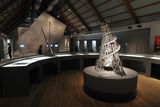
View of the exhibition
View of the exhibition in the Schloss Neuhardenberg Foundation exhibition hall.
Photo: Claus Bach. Source: Buchenwald and Mittelbau-Dora Memorials Foundation
Photo: Claus Bach. Source: Buchenwald and Mittelbau-Dora Memorials Foundation

View of the exhibition
View of the exhibition in the Schloss Neuhardenberg Foundation exhibition hall.
Photo: Claus Bach. Source: Buchenwald and Mittelbau-Dora Memorials Foundation
Photo: Claus Bach. Source: Buchenwald and Mittelbau-Dora Memorials Foundation

Entrance area to the exhibition
The exhibition documents the history of the Gulag with the aid of relics of camp imprisonment and forced labour, as well as documents, pictures, maps, photos, and video and audio material.
Photo: Claus Bach. Source: Buchenwald and Mittelbau-Dora Memorials Foundation
Photo: Claus Bach. Source: Buchenwald and Mittelbau-Dora Memorials Foundation

Model of Tatlin's Tower, object installation and map of the Soviet Union
At the centre of the entrance area to the exhibition is a model of Vladimir Tatlin's design for the "Monument to the Third Communist International". A cosmic-planetary order, the Bolshevist Revolution and the new political world order have been made to harmonize here, at least aesthetically. Under Stalin, the hope of salvation associated with this image was to become a catalyst for misanthropic action in the name of progress and the liberation of the people.
Photo: Claus Bach. Source: Buchenwald and Mittelbau-Dora Memorials Foundation
Photo: Claus Bach. Source: Buchenwald and Mittelbau-Dora Memorials Foundation

Object installation
In the late 1980s, the staff of “Memorial” began salvaging remnants of the Gulag system from the ruins of former camps.
Photo: Claus Bach. Source: Buchenwald and Mittelbau-Dora Memorials Foundation
Photo: Claus Bach. Source: Buchenwald and Mittelbau-Dora Memorials Foundation

Object installation and map of the Soviet Union
The locations of the camp complexes and their administrations are shown on a large-scale map installed behind the relics of the camps. Three touchscreens embedded in the map offer means of exploring the dimensions of the Gulag with the aid of graphs and diagrams. A further monitor provides basic information on other camp systems in Germany and the Soviet Union.
Photo: Claus Bach. Source: Buchenwald and Mittelbau-Dora Memorials Foundation
Photo: Claus Bach. Source: Buchenwald and Mittelbau-Dora Memorials Foundation

“Monument to the Third Communist International” by Vladimir Tatlin
At the centre of the entrance area to the exhibition is a model of Vladimir Tatlin’s design for the “Monument to the Third Communist International”.
Photo: Claus Bach. Source: Buchenwald and Mittelbau-Dora Memorials Foundation
Photo: Claus Bach. Source: Buchenwald and Mittelbau-Dora Memorials Foundation
The Gulag camps in the Soviet Union (1929-1961) top
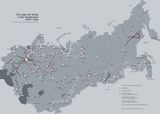
Map of the Gulag
Map of the Gulag according to information from the “Memorial” Society, Moscow
From October Revolution to Gulag top
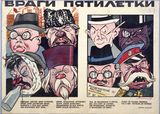
Enemies of the Five-Year Plan
Enemies of the Five-Year Plan. Poster by Viktor Deni, ca. 1930. In connection with the poster, the agitprop writer Demyan Bedny wrote satirical rhymes about “kulaks”, alcoholics, priests, corrupt journalists, capitalists, Mensheviks and “White Guards”. These groups would all declare war on the Five-Year Plan because it signified their demise.
Source: “Memorial” Collection, Moscow.
Source: “Memorial” Collection, Moscow.

Map of the USSR, 1931
Map of the USSR, 1931. Inscription at bottom right: “It’s different from the old maps. ‘The Five-Year Plan in action’. Unemployment has been eliminated. There is so much work for everybody that 160 million people do not suffice. Hundreds of major construction sites have not even been indicated here – there wouldn't be enough space on the map for all of the construction sites.”
Source: “Memorial” Collection, Moscow
Source: “Memorial” Collection, Moscow
Persecution and deportation top

Report by Janusz Bardach
J. Bardach (1919–2002), 1941. (1:20 min.)
Sentenced to death for alleged espionage, later commutation of punishment to 10 years of camp imprisonment in the Kolyma Region; early release in 1945.
Source: Janusz Bardach and Kathleen Gleeson: Man Is Wolf to Man: Surviving the Gulag, Berkeley, 1999.
Sentenced to death for alleged espionage, later commutation of punishment to 10 years of camp imprisonment in the Kolyma Region; early release in 1945.
Source: Janusz Bardach and Kathleen Gleeson: Man Is Wolf to Man: Surviving the Gulag, Berkeley, 1999.

Letter of complaint from Vsevolod Meyerhold
Letter of complaint from Vsevolod Meyerhold to the chairman of the Council of People’s Commissars of the USSR, Vyacheslav Molotov, 13 Jan 1940. (2:20 min.)
W. Meyerhold (1874–1940), Russian stage director, arrested in 1939 on charges of anti-Soviet agitation, sentenced to death by shooting in 1940.
Source: David King: Red Star over Russia, New York, 2009.
W. Meyerhold (1874–1940), Russian stage director, arrested in 1939 on charges of anti-Soviet agitation, sentenced to death by shooting in 1940.
Source: David King: Red Star over Russia, New York, 2009.

Letter from Hugo Eberlein
Letter from Hugo Eberlein to his partner, November 1939. (1:50 min.)
H. Eberlein (1887–1941), sentenced to 15 years of camp imprisonment in 1937 for alleged membership in a terrorist group of the Comintern apparatus; sentenced to death in 1941.
Source: Reinhard Müller: Der Fall des Antikomintern-Blocks. Jahrbuch für Historische Kommunismusforschung, Berlin, 1996.
H. Eberlein (1887–1941), sentenced to 15 years of camp imprisonment in 1937 for alleged membership in a terrorist group of the Comintern apparatus; sentenced to death in 1941.
Source: Reinhard Müller: Der Fall des Antikomintern-Blocks. Jahrbuch für Historische Kommunismusforschung, Berlin, 1996.
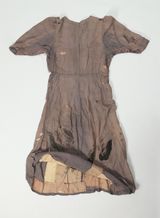
Valentina Bukhanevich-Antonova’s summer dress
Valentina Bukhanevich-Antonova’s summer dress, 1938/39. This was the dress V. Bukhanevich-Antonova was wearing when she was arrested. She wore it for a full year in detention in three prisons in Moscow.
Source: “Memorial” Collection, Moscow. Photo: Peter Hansen
Source: “Memorial” Collection, Moscow. Photo: Peter Hansen
Forced labour, survival and death in the camp top
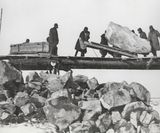
Unloading large rocks
Unloading large rocks on the White Sea – Baltic Canal, 1932.
Source: “Memorial” Collection, Moscow
Source: “Memorial” Collection, Moscow
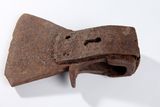
Axe blade
Provisionally repaired axe blade without handle, camp on Vaygach Island (Arctic Sea), 1930s.
Source: “Memorial” Collection, Moscow. Photo: Peter Hansen
Source: “Memorial” Collection, Moscow. Photo: Peter Hansen

Report by Gustav Herling-Grudzinski
Report by Gustav Herling-Grudzinski, 1953. (1 min.)
G. Herling-Grudzinski (1919–2000), Polish writer, essayist and journalist, conviction in 1940, camp imprisonment in the Arkhangelsk Region, released in 1942 in connection with the formation of a Polish army.
Source: Gustav Herling: A World Apart, New York, 2008.
G. Herling-Grudzinski (1919–2000), Polish writer, essayist and journalist, conviction in 1940, camp imprisonment in the Arkhangelsk Region, released in 1942 in connection with the formation of a Polish army.
Source: Gustav Herling: A World Apart, New York, 2008.
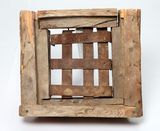
Barred window from an isolation cell
Barred window from an isolation cell in a camp along the Salekhard-Igarka transpolar railway, early 1950s.
Source: “Memorial”, Moscow. Photo: Peter Hansen
Source: “Memorial”, Moscow. Photo: Peter Hansen
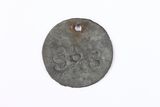
Grave tag
Metal tag with embossed registry number, camp near Lake Baikal, early 1950s. In some camps, tags were fixed to the toes of deceased inmates.
Source: “Memorial” Collection, Moscow. Photo: Peter Hansen
Source: “Memorial” Collection, Moscow. Photo: Peter Hansen
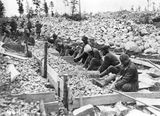
Inmates crushing stones
Inmates crushing stones, White Sea – Baltic Canal, 1932.
Source: “Memorial” Collection, Moscow
Source: “Memorial” Collection, Moscow
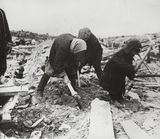
Inmates’ children working with their parents
Inmates’ children working with their parents, White Sea – Baltic Canal, 1932.
Source: “Memorial” Collection, Moscow
Source: “Memorial” Collection, Moscow

Camp inmates in front of their earthen hut
Camp inmates in front of their earthen hut in a camp on the Volga, 1940s.
Source: Russian Federation State Archive, Moscow
Source: Russian Federation State Archive, Moscow
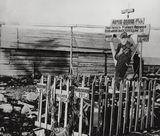
Final resting place for the slackers...
“Final resting place for the slackers of the first camp point”. Propaganda installation, White Sea – Baltic Canal, 1932. The symbolic gravesite served as a means of humiliating those unable to meet their work quota, and a blatant threat to everyone else.
Source: “Memorial” Collection, Moscow
Source: “Memorial” Collection, Moscow
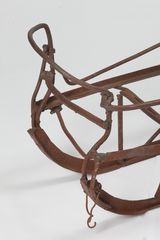
Metal sled for transporting heavy loads
Metal sled for transporting heavy loads, Kolyma Region, 1940s. There were hardly any surfaced roads or paths in the camps in this region.
Source: “Memorial” Collection, Moscow. Photo: Peter Hansen
Source: “Memorial” Collection, Moscow. Photo: Peter Hansen
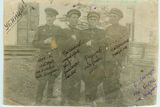
Officers of the camp guard unit
Officers of the camp guard unit, camp near the colony of Yagodnoye (Kolyma Region), 1940s. The handwritten memos on the photo read: “Murderers!”, “Head of the camp on the Olka, Yagodnoye Colony”, “Zygankov, undercover agent, killed by prisoners”, “Fyodorov, member of the MGB staff”, “Prison director”. These captions were written by a former camp inmate who later gave the photo to the staff of the “Memorial” Society.
Source: “Memorial” Collection, Moscow
Source: “Memorial” Collection, Moscow

Eye damages
“Eye damages caused by avitaminosis”. Lecture material belonging to camp physician Yekaterina Golts, with hand-drawn display panels for a camp physicians’ conference, December 1941, 44 pages.
Source: “Memorial” Collection, Moscow. Photo: Peter Hansen
Source: “Memorial” Collection, Moscow. Photo: Peter Hansen

Handmade “Lyubochka” doll
Handmade “Lyubochka” doll, Potma Camp (Mordovian ASSR), 1941. The prisoner Alexandra Stogova made the doll for herself as a reminder of her daughter. While she herself was imprisoned in the camp, her daughter volunteered to fight at the front and earned various high distinctions.
Source: “Memorial” Collection, Moscow. Photo: Peter Hansen
Source: “Memorial” Collection, Moscow. Photo: Peter Hansen
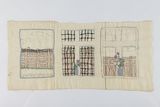
Embroidery (triptych)
View from the interior of a barrack, embroidery by an anonymous female camp inmate, Inta (Vorkuta Region), late 1940s.
Source: “Memorial” Collection, Moscow. Photo: Peter Hansen
Source: “Memorial” Collection, Moscow. Photo: Peter Hansen
Dissolution of the Gulag system and memories of the Gulag top

Report by Tatiana Moiseeva
Report by Tatiana Moiseeva, jurist of the Krasnoyarsk “Memorial” Society, on the problems of rehabilitating victims of political repressions in Krasnoyarsk, at the conference entitled “Human Rights in the Krasnoyarsk Region”, 2006. (1:40 min.)
Source: “Memorial” Collection, Krasnoyarsk
Source: “Memorial” Collection, Krasnoyarsk

Report by Wanda Bronska-Pampuch
Report by Wanda Bronska-Pampuch, 1957. (0:40 min.)
W. Bronska-Pampuch (1911–1972), translator and publicist, sentenced to 10 years of forced labour in Moscow in 1938, inmate in a camp in the Kolyma Region from 1938 to 1947, on the staff of the press department of the Polish Military Mission in West Berlin in 1948, subsequently lived in the Federal Republic of Germany.
Source: Wanda Bronska-Pampuch: “Kein Tatbestand”, in: Der Monat, July 1957.
W. Bronska-Pampuch (1911–1972), translator and publicist, sentenced to 10 years of forced labour in Moscow in 1938, inmate in a camp in the Kolyma Region from 1938 to 1947, on the staff of the press department of the Polish Military Mission in West Berlin in 1948, subsequently lived in the Federal Republic of Germany.
Source: Wanda Bronska-Pampuch: “Kein Tatbestand”, in: Der Monat, July 1957.

Gulag records department photographs
Gulag records department photographs of inmates of the period from 1929 to 1953.
Source: “Memorial” Collection, Moscow
Source: “Memorial” Collection, Moscow
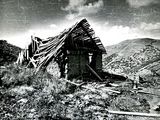
Camp ruins
Ruins of Butugichag Camp (Kolyma Region), 1994.
Photo: Ivan Panikarov
Photo: Ivan Panikarov
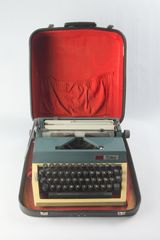
Typewriter
“Erika” model typewriter once belonging to Soya Metlitskaya. On this typewriter, the historian typed and copied critical texts by the songwriter and actor Vladimir Vysotsky, the writers Arkady and Boris Strugatsky and Aleksandr Solzhenitsyn, and the poet Osip Mandelstam, who died in the Gulag in 1938.
Source: “Memorial” Collection, Moscow. Photo: Peter Hansen
Source: “Memorial” Collection, Moscow. Photo: Peter Hansen
